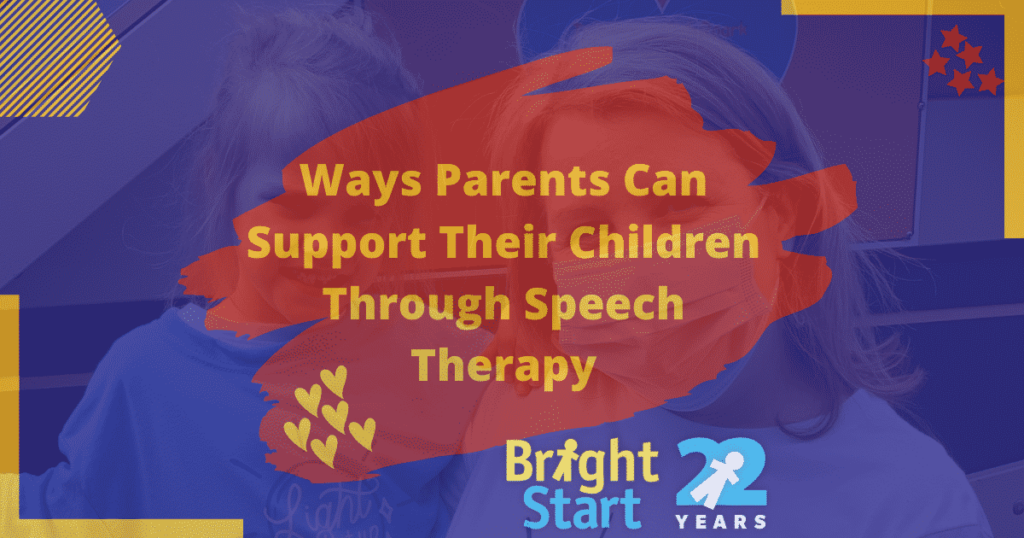
As a parent, it’s important to feel empowered and engaged in the educational process of developing your child’s speech. Here at Bright Start, we believe that families, parents, and caregivers are absolutely crucial to helping a child through developmental delays. That’s why, in all of our sessions, we don’t focus solely on teaching the child, but also on coaching you to continue supporting your child’s development throughout day-to-day life with them.
This article explains a few strategies you can implement to engage with your child during their speech therapy journey. It will help you feel confident about the important role you play in your child’s therapy plan.
Set Interactive Goals with your Child’s Speech Pathologist
Work with your child’s therapist to set goals that include you too. For instance, you can ask your therapist to assign “homework” activities that you can complete together with your child. These will often be fun games that encourage new words and sounds, and offer opportunities for you to talk and play with your child.
You will find that speech development can be coupled with many everyday tasks. Activities which combine physical movements and speech together at the same time are wonderful ways to encourage speech formation for your child. Games like peek-a-boo and hopscotch or common tasks like eating or teeth brushing – they all provide great opportunities for your Speech Language Pathologist to show you how you can help your child improve their words and linguistic skills.
Facilitate Play with “PRIDE”
Child-led play is one of the most enjoyable and memorable ways to support your child through speech therapy. The acronym “PRIDE” is an easy way to facilitate daily child-led play sessions.
PRIDE stands for: Praise, Reflection, Imitation, Description, and Enthusiasm.
- Praise: Tell your child what they’ve done well using specific descriptions, like, “Thank you for putting all of your blocks in the bin,” or, “You’ve made a wonderful drawing of a black cat!”
- Reflection: Make sure to listen and reflect upon what your child says, even if they haven’t verbalized it correctly. If your child says, “car fast,” instead of correcting them, respond with correct grammatical rules: “yes, the car is fast.” This way children can learn through supportive conversations, rather than correction or discouragement.
- Imitation: When your child performs a behavior, imitate it, and explain what you’re doing. For example, if your child adds a block to a tower, add a block to the tower as well. As you do, say, “I am building a tower.” This can be particularly useful when facilitating conversation in child-led play sessions.
- Description: Describe what you or your child is doing. This will help them vocalize their behaviors. For instance, you might say, “I’m putting a blue dress on Barbie,” or, “you are building a big castle.”
- Enthusiasm: Always show excitement for your child’s statements. If they say, “look at the blue bird,” you might show excitement for this statement with this reaction: “yes, that is a blue bird!” Children will continue the behaviors that receive your enthusiastic attention, a powerful method of positive reinforcement.
Practice Non-Goal-Oriented Conversation
Non-goal-oriented communication means talking about what your child is focused on, instead of asking them to do or think about something else. This helps improve your child’s self-esteem and attention span, while also helping them develop strategies for monitoring emotions like frustration or anger by communicating them to you.
This kind of engaged and supportive conversation can happen anywhere — in the grocery store, during car trips, or during meals. When you see something, like a car, describe it to encourage children to talk about the things they see and think. Give your child choices, explain your thoughts and actions, and make time to talk without any specific goal in mind. Just talk!
Review Achievements with your Speech Pathologist
Don’t forget to celebrate and reflect on every milestone. It’s important that you and your therapist recognize the impact of your hard work. With your therapist’s guidance, use reflection as an opportunity to set new shared goals for you and your child. Your relationship with your child’s therapist is just as important as your child’s relationship to them.
If you have questions or are struggling to implement strategies offered by your therapist, don’t hesitate to ask for clarification or help. You can reassess and determine more realistic goals that work better for your family. But most importantly, have fun!
